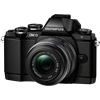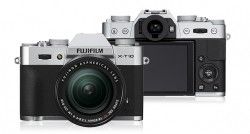Main
Model
Price
Advantages
launch
Announced
Body type
Camera subcategory
Sensor
Effective pixels
Max resolution
Sensor size
Sensor type
Processor
Image ratio w:h
Other resolutions
Sensor photo detectors
Image
ISO
Boosted ISO (minimum)
White balance presets
Custom white balance
Image stabilization
Image stabilization notes
Uncompressed format
JPEG quality levels
Boosted ISO (maximum)
Photography features
Minimum shutter speed
Maximum shutter speed
Aperture priority
Shutter priority
Manual exposure mode
Subject / scene modes
Built-in flash
Flash range
External flash
Flash modes
Continuous drive
Self-timer
Metering modes
Exposure compensation
AE Bracketing
WB Bracketing
Screen / viewfinder
Articulated LCD
Screen size
Screen dots
Screen type
Live view
Viewfinder type
Viewfinder coverage
Viewfinder magnification
Viewfinder resolution
Touch screen
Videography features
Resolutions
File Format
Microphone
Speaker
Optics & Focus
Autofocus
Manual focus
Number of focus points
Lens mount
Focal length multiplier
Physical
Weight (inc. batteries)
Dimensions
Environmentally sealed
Battery
Battery details
Battery Life (CIPA)
Storage
Storage types
Connectivity
USB
HDMI
Wireless
Wireless notes
Remote control
Microphone port
Headphone port
Other features
Orientation sensor
Timelapse recording
GPS
GPS notes
Samples
Videos
Summary
The Fujifilm X-T10 highest resolution of 4896 x 3264 pixels (16 megapixels) is better than the Olympus OM-D E-M10 maximum resolution of 4608 x 3456 pixels (16 megapixels). The Fujifilm X-T10 has bigger sensor than the Olympus OM-D E-M10: APS-C (23.6 x 15.6 mm) versus Four Thirds (17.3 x 13 mm). It is the most significant advantage of this camera as large sensor allows the camera owner to shoot photos of the more professional quality. The Fujifilm X-T10 offers a wider ISO range of 100-51000 than 200-25600 ISO range of the Olympus OM-D E-M10. Such ISO range let the camera owner to shoot better photos in more difficult situations. The Fujifilm X-T10 offers more number of white balance presets - 8. This specification gives the camera owner more control over colour. The Olympus OM-D E-M10 offers more focus points than the Fujifilm X-T10: 81 vs 77. More focus points means more convenience when attempting to focus on objects which are not centred.
The Olympus OM-D E-M10 screen is better as it has more screen dots 1,037,000 in compare to 920,000 dots of the Fujifilm X-T10 screen. The higher dot count screen is better for reviewing photos on your camera. The Olympus OM-D E-M10 offers better lowest shutter speed - 60 seconds.
The Fujifilm X-T10 battery life is better in compare to the Olympus OM-D E-M10 battery life. In accordance with CIPA standards you will be able to produce 350 photos with the X-T10 and only 320 with the OM-D E-M10. The X-T10 weighs 381g which is 15g less than the weight of the OM-D E-M10.
The X-T10 has 7 advantages and the Olympus OM-D E-M10 only 4 so the X-T10 will become the best choice. Check the list of the best offers on Amazon.


